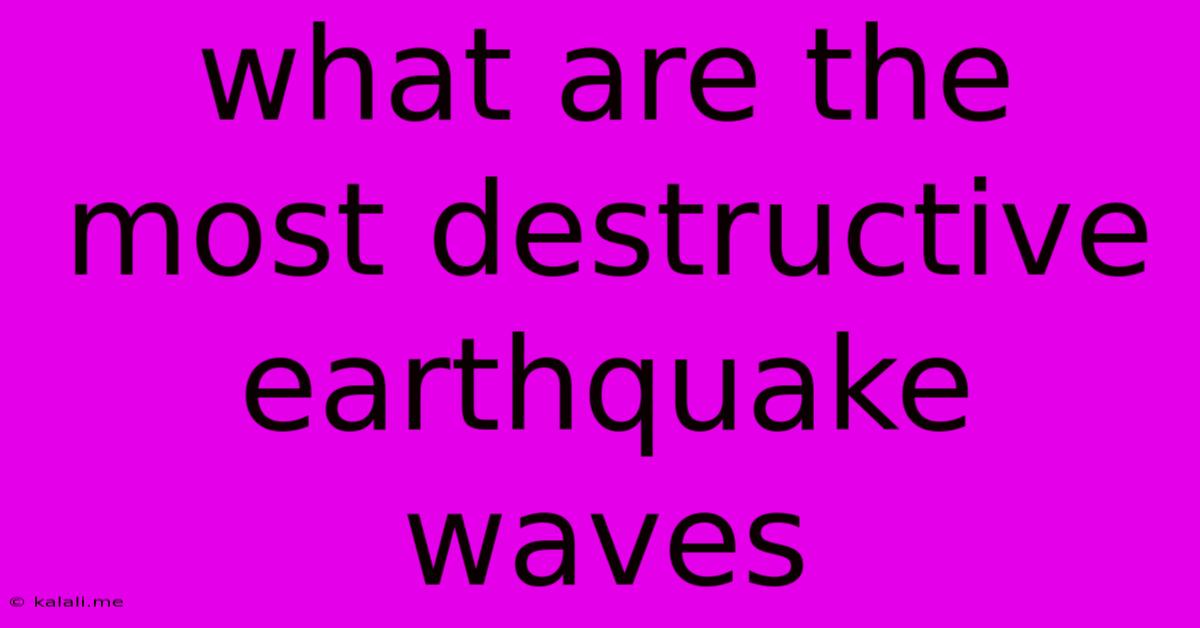What Are The Most Destructive Earthquake Waves
Kalali
Jun 13, 2025 · 3 min read

Table of Contents
What are the Most Destructive Earthquake Waves? Understanding Seismic Waves and Their Impact
Earthquakes, terrifying displays of nature's power, unleash a variety of seismic waves that radiate outwards from the hypocenter (focus). While several types exist, some are far more destructive than others. This article delves into the characteristics of these waves, explaining why they cause the most damage. Understanding these waves is crucial for building earthquake-resistant structures and mitigating the impact of future seismic events.
What are Seismic Waves?
Seismic waves are the vibrations that travel through the Earth's layers during an earthquake. These waves carry the energy released from the sudden rupture of tectonic plates. Different types of waves have different properties, affecting their speed, amplitude, and destructive potential.
The Destructive Duo: Surface Waves
The most destructive earthquake waves are surface waves. Unlike body waves that travel through the Earth's interior, surface waves travel along the Earth's surface. This proximity to the surface means they cause the most significant ground motion, leading to the extensive damage associated with earthquakes. There are two main types of surface waves:
1. Rayleigh Waves: The Rolling Motion
Rayleigh waves are named after Lord Rayleigh, who predicted their existence in 1885. These waves move in a rolling, elliptical motion, similar to waves rolling across the ocean's surface. They cause the ground to move up and down and back and forth, a combination of vertical and horizontal motion. This complex motion is particularly damaging to structures, as it can cause significant twisting and swaying. Rayleigh waves are generally slower than Love waves but often have larger amplitudes, making them highly destructive.
2. Love Waves: The Side-to-Side Shear
Love waves, named after A.E.H. Love, are shear waves that travel along the Earth's surface. Unlike Rayleigh waves, they move the ground primarily from side to side, perpendicular to the direction of wave propagation. This horizontal shaking can cause significant damage to buildings and infrastructure, especially those not designed to withstand lateral forces. Love waves are typically faster than Rayleigh waves but still incredibly destructive.
Body Waves: Less Destructive, but Still Significant
While surface waves cause the most damage, body waves also contribute to the overall seismic impact. These waves travel through the Earth's interior and are categorized into two types:
1. P-Waves (Primary Waves): The Compression
P-waves are compressional waves, meaning they move by compressing and expanding the material they pass through. They are the fastest seismic waves and arrive first at seismic monitoring stations. While they cause less ground shaking than surface waves, their arrival provides early warning before the more destructive waves hit.
2. S-Waves (Secondary Waves): The Shear
S-waves are shear waves, moving the ground perpendicular to the direction of wave propagation. They are slower than P-waves and cause more ground shaking. However, their destructive power is generally less than that of surface waves.
Conclusion: Understanding the Threat for Better Preparedness
Surface waves, particularly Rayleigh and Love waves, are the most destructive earthquake waves due to their large amplitudes and complex ground motions. Understanding their characteristics is vital for developing effective earthquake-resistant building designs, implementing early warning systems, and educating communities about earthquake safety. While P-waves and S-waves contribute to the overall earthquake impact, it's the surface waves that deliver the most devastating blows. Continued research and advancements in seismic monitoring and engineering are crucial for mitigating the risks posed by these powerful waves.
Latest Posts
Latest Posts
-
How Fast Does A Peacock Run
Jun 14, 2025
-
Which Of These Lines Is A Metaphor
Jun 14, 2025
-
Difference Between Quality Control And Quality Assurance Pdf
Jun 14, 2025
-
Gpa Requirements For University Of Memphis
Jun 14, 2025
-
What Are The Prime Factors Of 156
Jun 14, 2025
Related Post
Thank you for visiting our website which covers about What Are The Most Destructive Earthquake Waves . We hope the information provided has been useful to you. Feel free to contact us if you have any questions or need further assistance. See you next time and don't miss to bookmark.